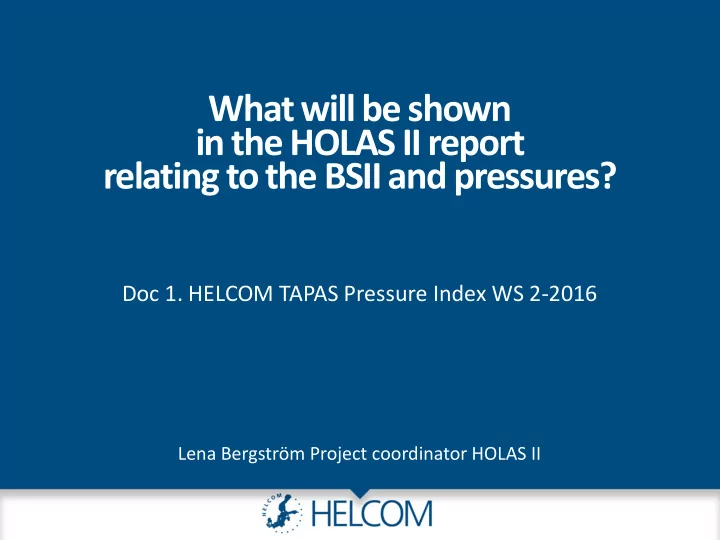

What will be shown in the HOLAS II report relating to the BSII and pressures? Doc 1. HELCOM TAPAS Pressure Index WS 2-2016 Lena Bergström Project coordinator HOLAS II
This presentation: • Information on the overall HOLAS II reporting • Propose how outputs from the Baltic Sea Impact Index can be presented in HOLAS II
Preliminary draft outline of the printed HOLAS II report Summary • Introduction • Basic characteristics of the Baltic Sea – Policy framing – Outline of the project working process – Methods • Assessment of good environmental status • Effects on human well-being/Cost of degradation • Human activities and pressures acting on the • environment Spatial distributions – Trends – Socioeconomic importance – BSII outputs – Measures towards reaching GES • Conclusions and future outlook •
Overview of HOLAS II outputs at different level of detail ”Chapters in the report” Results by species groups, themes, integrated assessments Results by indicator/spatial data sets (online)
Linking of the different components Baltic Sea pressure and impact index + ESA Drivers Responses Pressures Impacts Status of the (ecosystem ecosystem services)
Fact sheets Oil slicks and spills in the Baltic Sea 2003-2007 - For thematic layers or Description of the data The relative amount of oil spills and oil slicks in 5km × 5 km grid cells. In the map, the number of annual individual data observations per grid cell was classified to four classes: 0 (no spills/slicks), 1 (1-3 observations), 2 sets (4-6 observations and 3 (>6 annual observations). The annual data was summed over the years 2003-2007 and therefore the relative scale of the map exceeds the 0-3 scale. - To be presented online Data source: HELCOM Annual report on discharges observed during aerial surveillance in the Baltic Sea (http://www.helcom.fi/action-areas/response-to-spills/publications/). Attribute information: Grid cell ID, Center coordinates of grid cells, relative amount of slicks and spills (class scale), original number of observations per year. Spatial coverage : Entire Baltic Sea. Spatial resolution : The original data shows actual observation sites but this data layer is aggregated to 5km × 5 km grid cells over the Baltic Sea. Time period and temporal resolution : Data is summed for the period 2003-2007 and is based on annuals data from the HELCOM aerial surveillance flights which operate around the year. Data access: HELCOM data and map service (http://www.helcom.fi/baltic-sea-trends/data-maps). Limitations of use: Data can be used freely given that the source is cited. Responsible institution: HELCOM (www.helcom.fi).
Thematic fact sheets • Shows the spatial data sets used in the BSII (pressures and ecosystem components) • Presented online, including a method description on how they were developed. – To explore: should the sensitivity scores be presented in these sheets • The spatial data sets are to be presented for approval over a workspace
Technical fact sheets • Technical information on all spatial data underlying the analyses • Metadata including data quality aspects • For countries to accept via workspace. – In some cases thematic fact sheets and technical fact sheets may contain identical information
Socioeconomic importance: Regional use of marine waters analysis Economic indicators based on national statistics Presented for selected sectors To be developed further in the TAPAS ESA theme 9
Pressures acting on the environment
For comparison: Pressures in HOLAS 2010 Maps of single pressure Top 10 riverine loads Cumulative impacts distribution and intensity Temporal trends 11
Pressures in HOLAS 2010 Sub-basin summaries Top 20 impacts in the region Top impacts per sub-basins 12
Assessment of pressures in HOLAS II – Cumulative spatial distribution of pressures and impacts on the Baltic Sea (this workshop) – Trends over time for selected pressures – Pressure core indicators
1. Spatial distribution of pressures and impacts • Given by the Baltic Sea Pressure and Impact Index • The pressures to be included are aggregated into themes, which may also be of interest to display separately
2. Trends over time for selected pressures • May be obtained from ongoing HELCOM reporting and assessments – PLC for hazardous substances and nutrient loading (Annex 2) – ICES regarding the fishing mortality – Data sets reflecting physical or hydrological disturbance, long term time series are typically not available.
3. Pressure core indicators • The HELCOM core indicators contains three pressure core indicators, which are linked to pressures listed in EU MSFD Annex III. – Number of drowned mammals and waterbirds in fishing gear – Inputs of nitrogen and phosphorous to the sub-basins, and – Oil-spills affecting the marine environment. • Agreed targets exist for the latter two indicators
The environmental target of the pressure core indicator ’Oil-spills affecting the marine environment’ is based on a modern baseline of estimated volume of oil-spills during the reference period 2008- 2013 (red rectangle) during which the volumes were found to be low in a historical perspective. Total input of phosphorous from 1995-2012 divided into different sources, with trendline (green) and the MAI target (red line). Similar figures are available for the respective sub-basin.
Ways to identify pressures to focus on Identify pressures that: • have a strong influence according to the cumulative impact index BSPII • are of high public interest • are considered as emerging pressures • can be represented by data on both spatial and temporal information • are reflected in the core pressure indicators.
9/6/2016 19
Overview types of pressures Name 9/6/2016 Surname 20
Recommend
More recommend